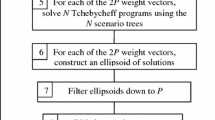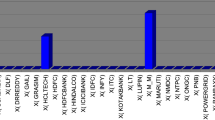Abstract
We study a stochastic programming approach to multicriteria multi-period portfolio optimization problem. We use a Single Index Model to estimate the returns of stocks from a market-representative index and a random walk model to generate scenarios on the possible values of the index return. We consider expected return, Conditional Value at Risk and liquidity as our criteria. With stocks from Istanbul Stock Exchange, we make computational studies for the two and three-criteria cases. We demonstrate the tradeoffs between criteria and show that treating these criteria simultaneously yields meaningful efficient solutions. We provide insights based on our experiments.
Similar content being viewed by others
References
Abdelaziz F.B., Aouni B., Fayedh R.E.: Multi-objective stochastic programming for portfolio selection. Eur. J. Oper. Res. 177, 1811–1823 (2007)
Balıbek E., Köksalan M.: A multi-objective multi-period stochastic programming model or public debt management. Eur. J. Oper. Res. 205(1), 205–217 (2010)
Beale E.M.L.: On minimizing a convex function subject to linear inequalities. J. R. Stat. Soc. (Series B) 17(2), 173–184 (1955)
Bertsimas D., Darnell C., Soucy R.: Portfolio construction through mixed-integer programming at Grantham, Mayo, Van Otterloo and Company. Interfaces 29(1), 49–66 (1999)
Bertsimas D., Shioda R.: Algorithm for cardinality-constrained quadratic optimization. Comput. Optim. Appl. 43, 1–22 (2009)
Bodie Z., Kane A., Marcus A.J.: Investments. McGraw-Hill International Edition, New York (2009)
Buguk C., Brorsen W.: Testing weak-form market efficiency: evidence from the istanbul stock exchange. Int. Rev. Financial Anal. 2, 579–590 (2003)
Campbell J.Y., Lo A.W., MacKinlay A.C.: The Econometrics of Financial Markets. Princeton University Press, Princeton (1997)
Cesarone, F., Scozzari, A., Tardella, F. (2012). A new method for mean-variance portfolio optimization with cardinality constraints. Ann. Oper. Res. doi: 10.1007/s10479-012-1165-7
Chang T.J., Meade N., Beasley J.E., Sharaiha Y.M.: Heuristics for cardinality constrained portfolio optimisation. Comput. Oper. Res. 27, 1271–1302 (2000)
Dantzig G.B.: Linear programming under uncertainty. Manag. Sci. 1(3&4), 197–206 (1955)
Dupacova J., Consigli G., Wallace S.W.: Scenarios for multistage stochastic programs. Ann. Oper. Res. 100, 25–53 (2000)
Ehrgott M., Tenfelde-Podehl D.: Computing nadir values in three objectives. Lecture Notes Econ. Math. Syst. 507, 219–228 (2001)
Ehrgott M., Klamroth K., Schwehm C.: An MCDM approach to portfolio optimization. Eur. J. Oper. Res. 155, 752–770 (2004)
Fama E.F., French K.R.: Common risk factors in the returns on stocks and bonds. J. Financial Econ. 33, 3–56 (1993)
Guastaroba G., Mansini R., Speranza M.G.: On the effectiveness of scenario generation techniques in single-period portfolio optimization. Eur. J. Oper. Res. 192, 500–511 (2009)
Gülpınar N., Rustem B., Settergren R.: Multistage stochastic mean-variance portfolio analysis with transaction costs. Innov. Financ. Econ. Netw. 3, 46–63 (2003)
Haimes Y.Y., Lasdon L.S., Wismer D.A.: On a bicriterion formulation of the problems of integrated system identification and system optimization. IEEE Trans. Syst. Man Cybern. 1(3), 296–297 (1971)
Hoyland K., Wallace S.W.: Generating scenario trees for multistage decision problems. Manag. Sci. 47(2), 295–307 (2001)
Ibrahim K., Kamil A.A., Mustafa A.: Portfolio selection problem with maximum downside deviation measure: a stochastic programming approach. Int. J. Math. Models Methods Appl. Sci. 1(2), 123–129 (2008)
Konno H.: Piecewise linear risk function and portfolio optimization. J. Oper. Res. Soc. 33, 139–156 (1990)
Konno H., Yamazaki H.: Mean absolute deviation portfolio model and its applications to Tokyo stock market. Manag. Sci. 37, 519–531 (1991)
Lo A.W., MacKinlay A.C.: Stock market prices do not follow random walks: evidence from a simple specification test. Rev. Financ. Stud. 1, 41–66 (1988)
Markowitz H.: Portfolio Selection: Efficient Diversification of Investments. Wiley, New York (1959)
Michalowski W., Ogryczak W.: Extending the MAD portfolio optimization model to incorporate downside risk aversion. Naval Res. Logist. 48, 186–200 (2001)
Odabasi A., Aksu C., Akgiray V.: The statistical evolution of prices on the Istanbul stock exchange. Eur. J. Financ. 10, 510–525 (2004)
Pınar M.Ç.: Robust scenario optimization based on downside- risk measure for multi-period portfolio selection. OR Spectr. 209, 295–309 (2007)
Poterba J., Summers L.: Mean reversion in stock prices: evidence and implications. J. Financ. Econ. 22, 27–59 (1988)
Rockafellar R.T., Uryasev S.: Optimization of conditional value-at-risk. J. Risk 2(3), 21–41 (2000)
Rockafellar R.T., Uryasev S.: Conditional value-at-risk for general loss distributions. J. Banking Financ. 26, 1443–1471 (2002)
Sarr, A., Lybek, T. (2002), Measuring Liquidity in Financial Markets. IMF Working Paper, WP/02/232
Seyhun H.N.: Insiders’ profits, costs of trading and market efficiency. J. Financ. Econ. 16(2), 189–212 (1986)
Skolpadungket, P., Dahal, K., Harnpornchai, N. (2007) Portfolio optimization using multi-objective genetic algorithms. IEEE Congr. Evol. Comput., 516–523
Smith G., Ryoo H.J.: Variance ratio tests of the random walk hypothesis for European emerging stock markets. Eur. J. Financ. 9, 290–300 (2003)
Steuer R.E., Qi Y., Hirschberger M.: Portfolio optimization: new capabilities and future methods. Zeitschrift für Betriebswirtschaft 76(2), 199–219 (2006)
Steuer R.E., Qi Y., Hirschberger M.: Suitable-portfolio investors, nondominated frontier sensitivity, and the effect on standard portfolio selection. Ann. Oper. Res. 152, 297–317 (2007)
Yu L., Wang S., Wu Y., Lai K.K.: A dynamic stochastic programming model for bond portfolio management. Lecture Notes Comput. Sci. 3039(2004), 876–883 (2004)
Yu L.Y., Ji X.D., Wang S.Y.: Stochastic programming models in financial optimization: a survey. Adv. Model. Optim. 5(1), 1–26 (2003)
Author information
Authors and Affiliations
Corresponding author
Rights and permissions
About this article
Cite this article
Tuncer Şakar, C., Köksalan, M. A stochastic programming approach to multicriteria portfolio optimization. J Glob Optim 57, 299–314 (2013). https://doi.org/10.1007/s10898-012-0005-2
Received:
Accepted:
Published:
Issue Date:
DOI: https://doi.org/10.1007/s10898-012-0005-2




